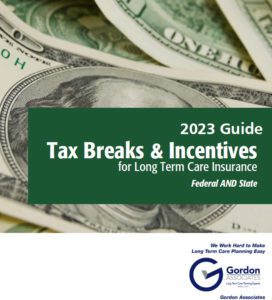With many clients re-evaluating asset and investment strategies due to unforeseen challenges in 2020, financial planning is now top of mind. Moreover, financial planning for Long Term Care should be considered an essential part of a retirement portfolio.
According to the US Department of Health & Human Services, more than two-thirds of the population over the age of 65 are likely to have a long term care event (LTCI Facts), such as Alzheimer’s or cancer. You never know if or when Long Term Care will be needed, and an unexpected accident, illness or injury can quickly change a person’s financial needs when they are faced with paying for assisted living, nursing home care or home health care. The best time to think about Long Term Care is before you need it.
Long Term Care Insurance – A Key Part of Today’s Retirement Portfolio
When you think about retirement planning with your clients, think about Long Term Care Insurance (LTCI) as guaranteed benefit/income. LTCI can be factored into asset allocation strategies to help balance a client’s portfolio, providing significant asset protection. It should be considered just like any other predictable income stream, unlike stocks that can fluctuate based on the market and economy.
If and when care is needed, it can be very costly given the average annual cost for home health care or facility care can be well over $100,000.…but with LTCI there is a plan in place and income set aside so you don’t have to dip into retirement savings to pay for big Long Term Care expenses.
As an alternative, you can choose to self-fund Long Term Care expenses. But when you weigh in the unpredictability of when a Long Term Care event could happen and how long you will need care, not to mention the cost of a caregiver or stay at a facility, the funds you need can be significant. And when you need Long Term Care, you typically need to act quickly, not giving you much time to plan. This can exacerbate your financial future when you consider:
- Liquidating assets to cover the costs – you will want to do this without compromising long term investment goals.
- Considering what to liquidate first – this can be challenging while undergoing a personal health crisis or new diagnosis.
- The amount of money needed to pay for Long Term Care – often difficult to predict and varies based on the type of care needed and the length of time care is needed.
Benefits of Including LTCI in Financial Planning
Along with LTCI’s guaranteed benefits, LTCI can include inflation protection as a safeguard against the rising costs of Long Term Care. The cost of in-home caregivers, home health agencies, and assisted living facilities are continuously rising. But when you purchase compound or simple inflation, this helps offset increasing costs for care.
There are also several tax advantages to help pay for LTCI:
- Federal and State Tax Deductions
- 2020 LTC Tax-Free Benefit ($380/day)
- 1035 Exchange – Conversion of the cash value of a life insurance policy to use to add on LTCI, creating a Hybrid Asset-Based Life with LTCI Rider. Or, take advantage of an available annuity to create an Annuity with LTCI Rider with a higher value of benefits compared to the annuity’s value. For example, a $200,000 annuity can pay out $200,000 in value or be utilized to purchase a Hybrid LTCI with total benefits of $500,000 guaranteed (varies by carrier, state, age and gender).
- Health Savings Account (HSA) – Take out an age-based dollar amount from a health savings account to help pay Long Term Care Insurance premiums. Keep in mind there are rules based on age so it’s a good idea to consult plan benefit publications.
- Gifting – If you gift money to a family member (based on IRS limits), the gifted amount can be used to help pay for LTCI premiums. There is a tax-free advantage to the recipient, and, it reduces the estate size of the gift provider upon death.
- Cash Indemnity Plans – When you are eligible for benefits, the policyholder has the flexibility to pay anyone. This does not require submission of a receipt or invoice. And, it gives the policyholder more flexibility to select their own caregiver vs. a Reimbursement Plan that has more regulations (such as licensed caregivers and state guidelines). The cash indemnity option is particularly helpful with home health care…you can even pay a family member or non-licensed caregiver.
Financial planning for Long Term Care provides individuals with a guaranteed benefit/income. Remember that market downturns do not affect policy benefits and it’s something your client and their family can always rely on. During times like these, when unexpected challenges take place, it is important to have a secure financial strategy that can provide guaranteed benefits/income for your client and their family’s future. After all, Long Term Care planning plays an important role in securing a financial plan that many people have worked to build for themselves and their family.
For more information about long term planning, please contact us.


 To help determine if long-term care (LTC) insurance is right for you, we are offering a FREE informational guide. This is a comprehensive booklet that will answer many of your questions about tax breaks and incentives for LTCI for federal and state taxes.
To help determine if long-term care (LTC) insurance is right for you, we are offering a FREE informational guide. This is a comprehensive booklet that will answer many of your questions about tax breaks and incentives for LTCI for federal and state taxes. To help determine if long-term care (LTC) insurance is right for you, we are offering a FREE informational guide. This is a comprehensive booklet that will answer many of your questions about LTC and assist you with your health care planning.
To help determine if long-term care (LTC) insurance is right for you, we are offering a FREE informational guide. This is a comprehensive booklet that will answer many of your questions about LTC and assist you with your health care planning.